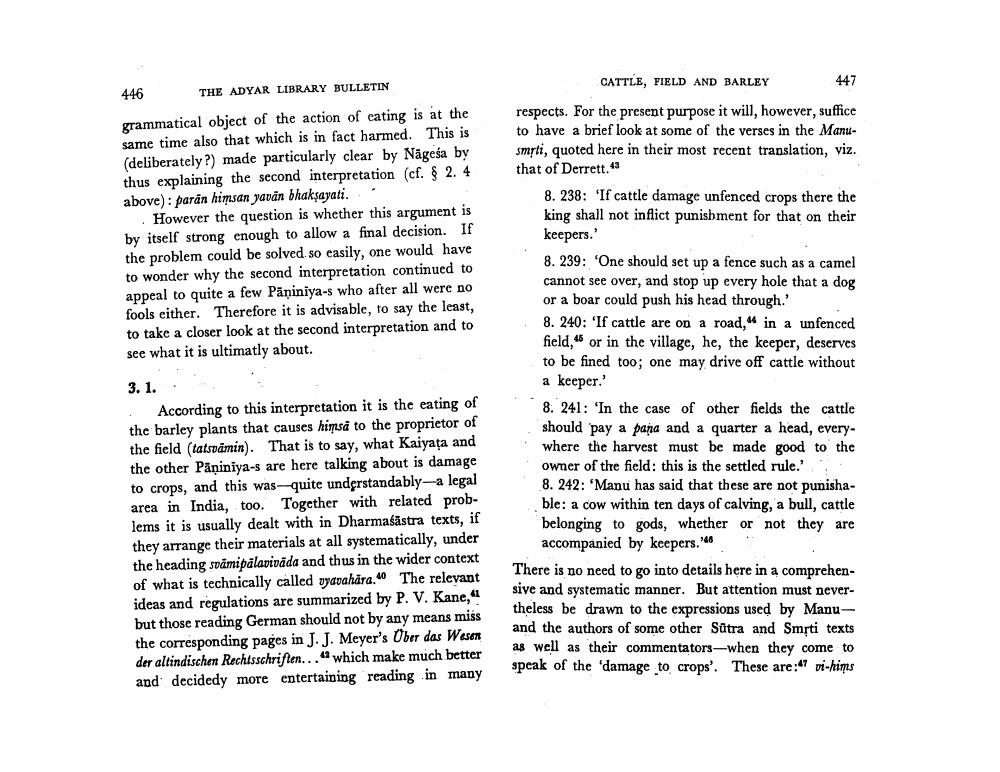Book Title: Cattle Field And Barley Note On Mahabhasya Author(s): A Wezler Publisher: A Wezler View full book textPage 9
________________ CATTLE, FIELD AND BARLEY 447 446 THE ADYAR LIBRARY BULLETIN grammatical object of the action of eating is at the same time also that which is in fact harmed. This is (deliberately?) made particularly clear by Nägesa by thus explaining the second interpretation (cf. § 2. 4 above): parän himsan yavân bhakşayati. . However the question is whether this argument is by itself strong enough to allow a final decision. If the problem could be solved. so easily, one would have to wonder why the second interpretation continued to appeal to quite a few Pāņiniya-s who after all were no fools either. Therefore it is advisable, to say the least, to take a closer look at the second interpretation and to see what it is ultimatly about. 3. 1. respects. For the present purpose it will, however, suffice to have a brief look at some of the verses in the Manusmrti, quoted here in their most recent translation, viz. that of Derrett.43 8. 238: 'If cattle damage unfenced crops there the king shall not inflict punishment for that on their keepers.' 8. 239: 'One should set up a fence such as a camel cannot see over, and stop up every hole that a dog or a boar could push his head through.' 8. 240: 'If cattle are on a road," in a unfenced field," or in the village, he, the keeper, deserves to be fined too; one may drive off cattle without a keeper.' 8. 241: 'In the case of other fields the cattle should pay a pana and a quarter a head, everywhere the harvest must be made good to the owner of the field: this is the settled rule. 8. 242: Manu has said that these are not punishable: a cow within ten days of calving, a bull, cattle belonging to gods, whether or not they are accompanied by keepers.' There is no need to go into details here in a comprehensive and systematic manner. But attention must nevertheless be drawn to the expressions used by Manuand the authors of some other Sūtra and Smsti texts as well as their commentators-when they come to speak of the 'damage to crops'. These are:? vi-hims . According to this interpretation it is the eating of the barley plants that causes himsa to the proprietor of the field (tatsämin). That is to say, what Kaiyata and the other Päņiniya-s are here talking about is damage to crops, and this was quite understandably-a legal area in India, too. Together with related problems it is usually dealt with in Dharmaśāstra texts, if they arrange their materials at all systematically, under the heading svämipalavivāda and thus in the wider context of what is technically called vyavahara.40 The relevant ideas and regulations are summarized by P. V. Kane, but those reading German should not by any means miss the corresponding pages in J.J. Meyer's Über das Wesen der altindischen Rechtsschriften..." which make much better and decidedy more entertaining reading in manyPage Navigation
1 ... 7 8 9 10 11 12 13 14 15 16 17 18 19 20 21 22 23 24
